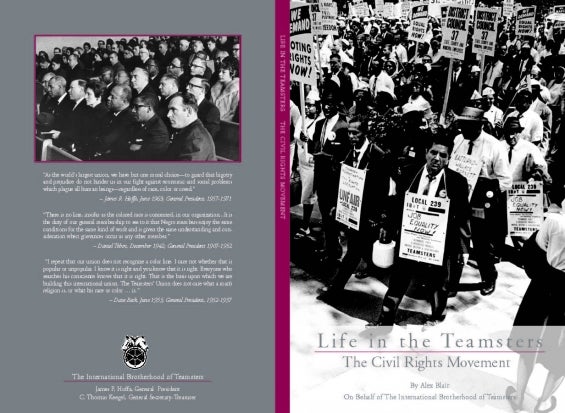Headline News
Teamsters and Civil Rights

In 2010, the Teamsters Union published “Life in the Teamsters: The Civil Rights Movement” as part of the Teamster History Collection. The book details how the labor and civil rights movements worked together to achieve dignity for working families.
The Teamsters, in particular, were early adopters of civil rights for its members.
“Life in the Teamsters: The Civil Rights Movement” covers the various partnerships of the Teamsters Union and the civil rights movement, including working with Dr. Martin Luther King Jr.
In an introduction to the book, Teamsters General President Jim Hoffa writes:
The 1.4 million men and women represented by the Teamsters Union are rightly proud of their contracts, union-negotiated benefits and grievance procedures. There is, however, a world of union history that many are not aware of. Our involvement with the civil rights movement, one of the most transformative periods in American history, is another reason our members should be so proud of our history.
I have always believed the Teamsters Union to be the most inclusive union in the world, but I may be biased. I grew up hearing about the Teamsters Union every day—what it was doing for its members, what it had done in the past and what it would continue to do. One thing my father was particularly proud of, and which I remain deeply committed to, is the idea that there is no color line within the Teamsters Union.
Reading this book shows that it wasn’t simply pride in his union that compelled my father to recount the union’s past civil rights victories and defeats. It was his genuine care that working men and women be treated fairly by their employer and it was his lifelong goal to keep moving America forward in this respect.
My father instilled in me the values of the labor movement, which includes that everyone should be treated with dignity and respect on the job. Part of that dignity and respect includes not paying wages based on skin color.
What this book shows is that the Teamsters stand up for our members no matter what. When the prevailing winds were blowing racism through a nation purportedly built on the notion that “All men are created equal,” the Teamsters stood strong.
No matter what the nation’s most powerful politicians say; no matter what the prevailing norms of the American labor movement are; no matter how much resistance they faced from employers who sought at all costs to keep workers divided—the Teamsters Union will continue to fight for equality in the same ways we have since the beginning.
One of the first crucial decisions facing these workers who were coming together to form the International Brotherhood of Teamsters in 1903 was regarding this issue. Would the union fall in line with the prevailing segregation in American society and become a whites-only union? Or would it fight segregation by organizing all workers and demanding economic justice for all workers?
It was as clear in 1903 as it is now: There is no color line in the Teamsters Union.
To pick up your own copy of “Life in the Teamsters Union,” contact your local union.